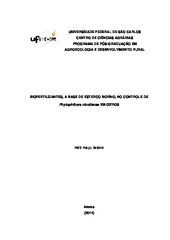| dc.contributor.author | Wehr, Pitt Paul | |
| dc.date.accessioned | 2016-06-02T18:57:51Z | |
| dc.date.available | 2014-10-20 | |
| dc.date.available | 2016-06-02T18:57:51Z | |
| dc.date.issued | 2014-07-08 | |
| dc.identifier.citation | WEHR, Pitt Paul. Biofertilizers, made of cattle manure sludge, in the control of phytophthora nicotianae in citrus. 2014. 73 f. Dissertação (Mestrado em Ciências Agrárias) - Universidade Federal de São Carlos, Araras, 2014. | por |
| dc.identifier.uri | https://repositorio.ufscar.br/handle/ufscar/179 | |
| dc.description.abstract | The objective of this study was to evaluate the effect of two organic liquid fertilizeres made from fresh cattle manure, produced under anaerobic digestion or forced oxygenation, for the control of Phytophthora nicotianae. Furthermore, we aimed to investigate separately the effect of the components in these products over the pathogen. For so, we tested the effect of cultivable microorganisms and the filtered fraction over the pathogen, targeting to identify the role of this factors in the disease control. It was found that biofertilizers have substances and microorganisms present in its composition capable of operating in the pathosystem in question, highlighting the role of baciliform heat resistant bacteria. It was observed that the effect of the filtered fraction of the anaerobic biofertilizer was effective on the mycelial growth of the pathogen and significantly higher than the filtered fraction of the aerobic biofertilizer, and had higher levels of some nutrients, especially calcium, copper and iron. The aerobic biofertilizer showed greater quantity and diversity of microorganisms antagonistic to P. nicotianae. The application of both biofertilizers reduced the number of infected roots of two citrus rootstocks (Citrus limonia and Citrus sunki) Both biofertilizers also reduced the amount of pathogen inoculum in the soil. In high concentrations biofertilizers cause phytotoxicity on young citrus plants, but in moderate concentrations, the products increased the number of germinated seeds of Rangpur lime and mandarin Sunki sown on soil inoculated with the pathogen. This makes the use of biofertilizers an option to be integrated in the disease management of P. nicotianae in citrus, however, more studies are require to investigate other issues, such as the risks related to the application of this products. | eng |
| dc.description.sponsorship | Financiadora de Estudos e Projetos | |
| dc.format | application/pdf | por |
| dc.language | por | por |
| dc.publisher | Universidade Federal de São Carlos | por |
| dc.rights | Acesso Aberto | por |
| dc.subject | Fertilizantes orgânicos | por |
| dc.subject | Biofertilizantes | por |
| dc.subject | Esterco bovino | por |
| dc.subject | Microorganismos | por |
| dc.subject | Fração filtrada | por |
| dc.subject | Filtrated fraction | eng |
| dc.subject | Antagonistic microorganisms | eng |
| dc.title | Biofertilizantes, a base de esterco bovino, no controle de
Phytophthora nicotianae em citros | por |
| dc.title.alternative | Biofertilizers, made of cattle manure sludge, in the control of phytophthora nicotianae in citrus | eng |
| dc.type | Dissertação | por |
| dc.contributor.advisor1 | Kupper, Katia Cristina | |
| dc.contributor.advisor1Lattes | http://lattes.cnpq.br/7900622063392740 | por |
| dc.description.resumo | O objetivo deste trabalho foi avaliar o efeito de um biofertilizante feito à base de esterco bovino, produzido sob digestão anaeróbica ou oxigenação forçada, no controle de Phytophthora nicotianae, mediante técnicas de avaliação in vitro e in vivo. Além disso, buscou-se investigar separadamente o efeito dos componentes presentes nestes produtos sobre o patógeno. Para tal, testou-se o efeito de microrganismos cultiváveis e da fração filtrada, visando identificar o papel dos fatores responsáveis pelo controle da doença. Verificouse que os biofertilizantes possuem substâncias e microrganismos presentes em sua composição capazes de atuar no patossistema em questão, havendo destaque para bactérias baciliformes termorresistentes. Observou-se que, o efeito da fração filtrada do biofertilizante anaeróbico foi efetivo sobre o crescimento micelial do patógeno e significativamente superior à fração filtrada do biofertilizante aeróbico, este, apresentou teores mais elevados de alguns nutrientes minerais, com destaque para cálcio, cobre e ferro. Já o biofertilizante aeróbico apresentou maior quantidade e diversidade de microrganismos antagônicos à P. nicotianae. A aplicação de ambos os biofertilizantes reduziu o número de raízes de porta-enxerto de citros (Citrus limonia e Citrus sunki) infectadas, assim como, a quantidade de inóculo do patógeno no substrato de plantio utilizado. Em concentrações elevadas os biofertilizantes causaram fitotoxicidade em plantas jovens de citros, mas em concentrações moderadas, os biofertilizantes elevaram o número de sementes germinadas de limão Cravo e tangerina Sunki, semeadas em substrato inoculado com o fitopatógeno. Isso faz do uso de biofertilizantes, uma opção para o manejo de P. nicotianae em citros, contudo novas pesquisas são necessárias para elucidar questões referentes ao seu uso prático e riscos referentes à sua aplicação. | por |
| dc.publisher.country | BR | por |
| dc.publisher.initials | UFSCar | por |
| dc.publisher.program | Programa de Pós-Graduação em Agroecologia e Desenvolvimento Rural - PPGADR-Ar | por |
| dc.subject.cnpq | CIENCIAS AGRARIAS | por |
| dc.contributor.authorlattes | http://lattes.cnpq.br/4866079661328873 | por |
